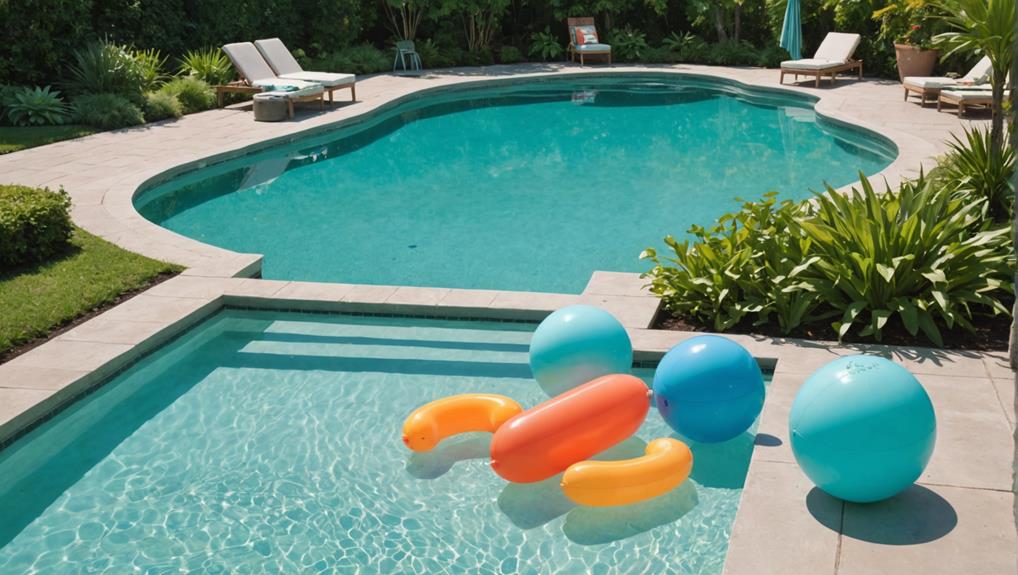You know that balanced pool chemicals are essential to maintaining a safe and healthy pool environment. Unbalanced chemicals can lead to algae growth, skin and eye irritation, and even corrosion of pool equipment and surfaces. Plus, it can result in costly repairs and replacements. To avoid these issues, you need to maintain ideal pH levels, alkalinity, calcium hardness, and sanitizer levels. Regular testing and adjustments are necessary to achieving perfect chemical harmony. By understanding the importance of each component, you'll be better equipped to create a balanced and safe pool environment – and discover the secret to a stress-free pool ownership experience.
Key Takeaways
- Balanced pool chemicals prevent algae growth, skin and eye irritation, and damage to the pool's structure and equipment.
- Ideal pH levels affect the effectiveness of pool sanitizers and prevent skin and eye irritation, with an ideal range of 7.4-7.6.
- Proper calcium hardness levels (200-400 ppm) prevent corrosion of pool equipment and damage to pool surfaces.
- Chemical imbalance can lead to costly repairs and replacements, emphasizing the importance of regular testing and maintenance.
- Balanced pool chemicals ensure the overall health and safety of the pool environment, making it safe for swimmers.
Understanding Chemical Balance
When you venture into the world of pool maintenance, grasping the concept of chemical balance is key to avoiding a host of problems that can plague your pool and its users. A proper chemical balance is essential to preventing algae growth, skin and eye irritation, and damage to the pool's structure and equipment. You must maintain the ideal pH level, which affects the effectiveness of pool sanitizers and prevents skin and eye irritation. Calcium hardness levels should also be kept in check, between 200-400 ppm, to prevent corrosion of pool equipment and damage to pool surfaces.
Importance of Ph Levels
Maintaining the ideal pH level is essential, as it directly impacts the effectiveness of sanitizers and the overall health of your pool and its users. You need to verify that your pool's pH levels are within the ideal range of 7.4-7.6 to prevent eye and skin irritation, corrosion of pool equipment, and damage to your pool's infrastructure.
pH levels outside the ideal range can reduce the effectiveness of sanitizers, causing eye and skin irritation, and damaging pool equipment.
pH imbalance can lead to corrosion of pool equipment, resulting in costly repairs and replacements.
A pH level of 7.0 is neutral, while values below 7.0 are acidic and above 7.0 are basic, making it essential to maintain a slightly alkaline pH level.
Alkalinity and Its Role
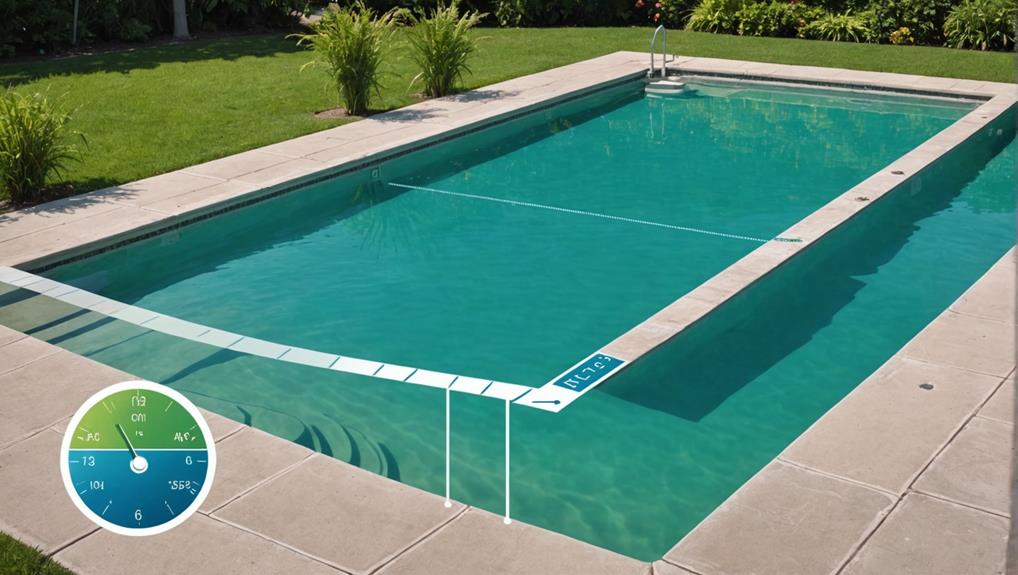
As you work to achieve balanced pool chemicals, you'll find that alkalinity plays a vital role in maintaining a stable pH. You're probably wondering how alkalinity accomplishes this – it's through its ph buffering capacity, which helps stabilize pH levels and neutralize acidity. By understanding these key functions, you'll be better equipped to manage your pool's chemistry and provide a comfortable swimming environment.
Ph Buffering Capacity
By understanding the essential role of Total Alkalinity in your pool's pH buffering capacity, you'll be better equipped to create a comfortable and safe swimming environment. Total Alkalinity measures the pool water's ability to resist changes in pH, with an ideal range of 80-120 parts per million (ppm). This range is imperative for stabilizing pH levels and maintaining a comfortable swimming environment.
Three key takeaways to keep in mind:
- A low Total Alkalinity level can lead to rapid pH changes, causing eye irritation, skin discomfort, and damage to pool equipment.
- Regular testing and adjustment of Total Alkalinity are necessary to maintaining a stable pH level, as it directly affects the efficacy of sanitizers and the overall health and safety of the pool environment.
- The ideal Total Alkalinity level varies depending on the type of pool, with vinyl liner pools requiring a slightly higher level than concrete or fiberglass pools to prevent premature aging of the liner.
Stabilizing Ph Levels
When you're trying to achieve a stable pH level in your pool, you need to focus on stabilizing the alkalinity, as it plays a critical role in buffering against sudden changes in the water's acidity or basicity. Total alkalinity (TA) should be maintained between 80-120 ppm to achieve a proper balance of pool chemicals. This range allows for a stable pH level, preventing sudden changes that can cause eye and skin irritation, corrosion of pool equipment, and inefficiency of sanitizers.
| Alkalinity Level | Effects on Pool |
|---|---|
| Low (below 80 ppm) | pH bounce, eye/skin irritation, equipment corrosion, sanitizer inefficiency |
| Ideal (80-120 ppm) | Stable pH, efficient sanitizer performance, safe swimming environment |
| High (above 120 ppm) | pH lock, difficulty adjusting pH, inefficient sanitizer performance |
| Saltwater Pools (60-80 ppm) | Lower TA required for stable sanitizer performance |
| Bromine-Sanitized Pools (120-150 ppm) | Higher TA required for efficient sanitizer performance |
Regular testing of total alkalinity levels is vital to maintain a stable and safe swimming environment. By maintaining the ideal alkalinity level, you can prevent pH fluctuations and guarantee your sanitizers work efficiently. This results in a safe and healthy pool environment for everyone to enjoy.
Neutralizing Acidity
You need to understand how alkalinity neutralizes acidity in your pool water to maintain a stable pH level. Alkalinity, measured in parts per million (ppm), is the capacity of your pool water to resist pH changes. When acidity levels rise, alkalinity helps neutralize it, preventing sudden pH swings that can damage your pool and equipment.
Three key reasons why alkalinity is essential in neutralizing acidity:
- pH Buffering: Alkalinity acts as a pH buffer, absorbing excess hydrogen ions that contribute to acidity, thereby maintaining a balanced pH level.
- Acidity Neutralization: Alkalinity reacts with acidic substances, such as carbon dioxide and hydrochloric acid, to neutralize their acidic effects on your pool water.
- Stable Water Chemistry: By neutralizing acidity, alkalinity helps maintain a stable water chemistry, ensuring that your pool water remains balanced and safe for swimmers.
Calcium Hardness Explained
Calcium hardness, a critical parameter in pool water chemistry, measures the concentration of calcium ions, which must be maintained between 200-400 parts per million (ppm) to prevent devastating consequences. As a pool owner, you must verify your calcium hardness level is within this range to prevent corrosion of pool equipment and scaling of pool surfaces. If your calcium hardness level falls below 200 ppm, your pool plaster may deteriorate, while levels above 400 ppm can lead to scaling and cloudy water. Maintaining the proper calcium hardness level is essential for a balanced pool, as it helps to stabilize pH levels and prevents sudden changes in water chemistry. You can adjust your calcium hardness level by adding calcium chloride or calcium carbonate to the pool water. Regular testing is necessary to guarantee ideal levels, as failure to do so can lead to costly repairs, equipment damage, and a shortened lifespan of the pool and its components. By maintaining the proper calcium hardness level, you'll be able to enjoy a safe, healthy, and long-lasting pool experience.
Sanitizers and Disinfectants
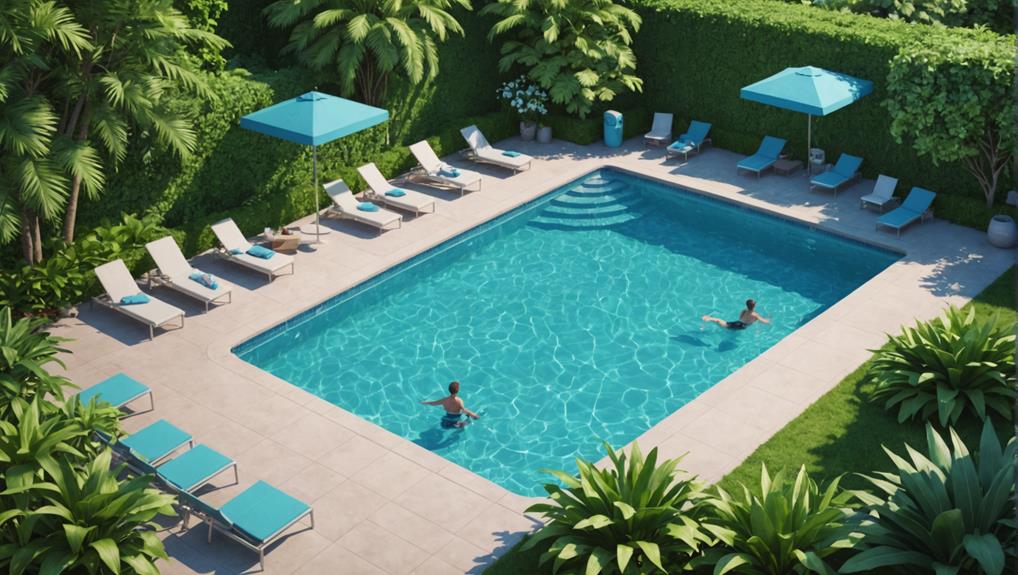
Maintaining the proper sanitizer and disinfectant levels is crucial to ensuring your pool water remains clean, clear, and safe for swimmers. As a pool owner, you need to understand the importance of sanitizers in pool chemistry.
- Sanitizers like chlorine and bromine work best in pool water with a pH level between 7.2 and 7.8, allowing them to effectively kill bacteria and other microorganisms.
- The ideal level of free chlorine in pool water is 0.5-1.5 parts per million (ppm), providing adequate sanitization while minimizing the risk of eye and skin irritation.
- Chlorine is the primary sanitizer used in pool water, and you must maintain a level of 1-3 ppm to effectively kill bacteria and prevent algae growth.
Filtration and Circulation Systems
As you focus on maintaining balanced pool chemicals, it's vital to think about the critical role filtration and circulation systems play in keeping your pool water clean and clear. You'll want to verify that your system is designed to optimize water flow, and that you're dedicated to regular maintenance tasks to keep it running efficiently. By doing so, you'll be able to reap the benefits of effective filtration and circulation, which include reduced chemical usage and a lower risk of algae growth and other pool-related issues.
System Design Matters
Your pool's filtration and circulation systems are the unsung heroes of balanced pool chemicals, working tirelessly behind the scenes to guarantee the water is clean, clear, and safe for swimmers. A well-designed system is vital for maintaining proper balance and facilitating effective sanitization.
Three key takeaways to keep in mind:
- A properly sized pump and filter can reduce the risk of cloudy water, algae growth, and equipment corrosion, while also minimizing energy costs and maintenance needs.
- The type and quality of filters used can substantially impact the effectiveness of the filtration system, with high-quality filters capable of capturing smaller particles and contaminants.
- Regular maintenance and cleaning of the filtration and circulation systems are essential to guarantee peak performance and prevent equipment failure.
Effective Water Flow
Proper circulation and filtration systems, which work in tandem to facilitate effective water flow, are critical components of a balanced pool, as they directly impact the overall health and appearance of the water. As a pool owner, you need to verify your pool has a minimum flow rate of 10 gallons per minute per 10,000 gallons of pool water for ideal circulation. A well-functioning filtration system is also essential for removing dirt, debris, and contaminants from the water. You have options like cartridge, sand, and diatomaceous earth filters, depending on your pool type and needs. Proper circulation is crucial for even distribution of sanitizers and other chemicals, preventing hotspots and areas of inadequate sanitization. When you maintain effective water flow, you'll enjoy clear and clean water, and prevent issues like cloudy or dirty water, algae growth, and corrosion of pool equipment and surfaces. By prioritizing circulation and filtration, you'll be able to maintain a balanced and healthy pool.
Regular Maintenance Needed
Regular maintenance of your filtration and circulation systems is essential to guarantee they continue to work efficiently and effectively in removing dirt, debris, and contaminants from the water. This maintains a clean and safe swimming environment, and prevents cloudy and dirty water that can make it difficult to maintain a properly balanced pool chemistry.
Three key reasons why regular maintenance is vital:
- Reduce Chlorine Levels and Skin Irritation: A well-maintained filtration system can reduce the amount of chlorine needed to sanitize the water, saving you money on chemicals and reducing the risk of eye and skin irritation.
- Maintain Ideal pH Levels: Regular circulation helps to distribute sanitizers and other chemicals evenly throughout the pool, allowing for proper sanitization and protection against algae growth, and maintaining pH levels that are favorable for swimmers.
- Prevent Costly Repairs: Failure to regularly clean and maintain the filtration system can lead to equipment failure, requiring costly repairs or even replacement, and potentially causing the pool to be closed for an extended period.
Managing Total Dissolved Solids
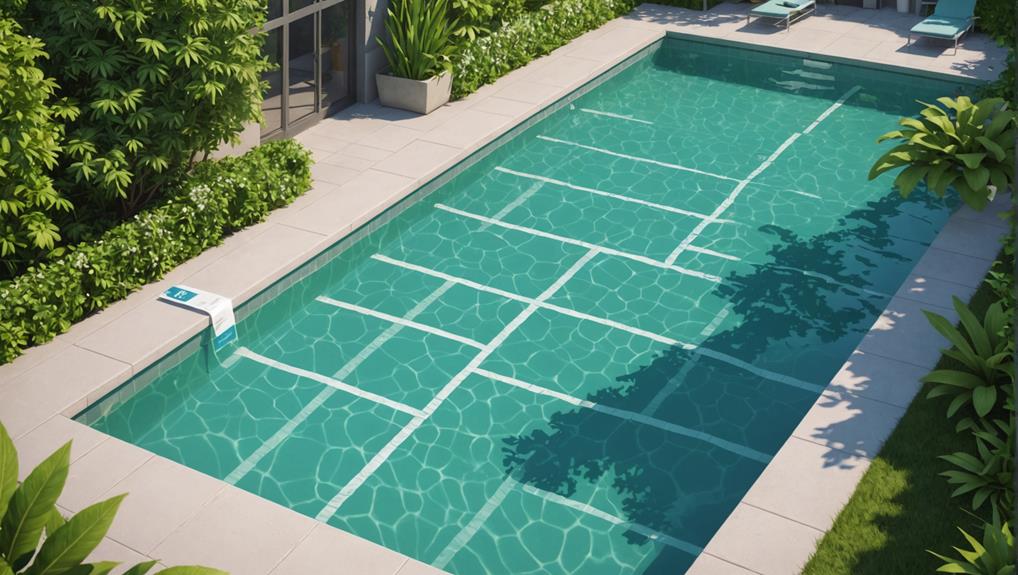
Maintaining a delicate balance of total dissolved solids (TDS) in your pool water is essential to preventing scaling, corrosion, and cloudy water. You need to maintain a balanced level of TDS to guarantee water clarity and prevent unwanted reactions. When TDS levels are too high, minerals can precipitate out of solution, causing scaling and cloudy water. On the other hand, low TDS levels can lead to corrosion of pool equipment and surfaces.
To avoid these issues, you should regularly test your pool water's TDS levels and adjust them as needed. A saturation index calculation can help you determine if your water is undersaturated, saturated, or supersaturated, which informs your TDS management strategy. By keeping your TDS levels in check, you'll prevent problems before they arise. Regular testing and adjustments will help you maintain a balanced pool environment, preserving your pool water remains clear, safe, and healthy for swimmers.
Water Testing and Analysis
You'll need to test your pool water frequently to maintain it remains balanced and safe for swimmers, which involves analyzing various parameters beyond just TDS levels. Understanding pool water requires more than just a glance at the surface – it demands regular testing and analysis.
- pH levels: Verify they're within the ideal range (7.2-7.8) to prevent eye irritation and equipment damage.
- Chlorine levels: Monitor free chlorine (1-3 ppm) and total chlorine (1-5 ppm) to maintain effective sanitizing and prevent algae growth.
- Alkalinity: Test for total alkalinity (80-120 ppm) to stabilize pH levels and prevent sudden changes.
Regularly test these parameters and adjust your chemical dosing accordingly. This process helps you maintain a delicate balance, guaranteeing a safe and enjoyable swimming experience. Water testing and analysis are vital aspects of pool maintenance, as they allow you to identify and address potential issues before they escalate. By regularly testing and adjusting your pool's chemistry, you'll be able to provide a healthy and safe environment for swimmers.
Achieving Optimal Chemical Harmony
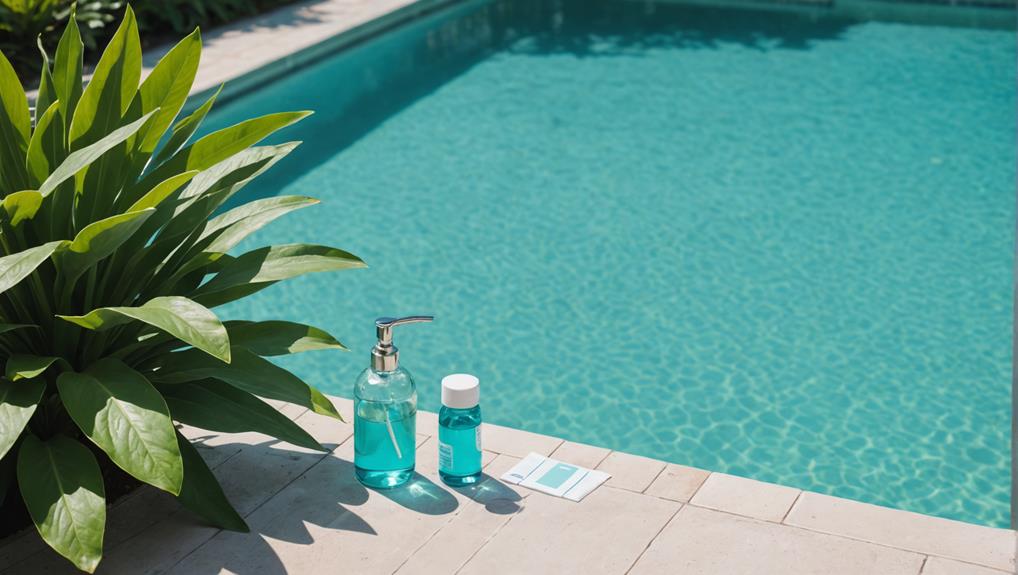
Achieving Ideal Chemical Harmony
By pinpointing the intricate relationships between pH, chlorine, and alkalinity levels, you can fine-tune your chemical dosing to achieve perfect harmony in your pool's water chemistry. This delicate balance is vital for proper maintenance and ensuring a safe, enjoyable swimming experience. When chlorine levels are high or too low, it can lead to eye irritation, respiratory issues, or even damage to your pool's equipment. Understanding how these parameters interact is key to achieving ideal harmony.
| Parameter | Ideal Range | Effects of Imbalance |
|---|---|---|
| pH | 7.2-7.8 | Eye irritation, skin problems, equipment damage |
| Chlorine | 1-3 ppm | Eye irritation, respiratory issues, ineffective sanitizing |
| Alkalinity | 80-120 ppm | pH instability, equipment damage, cloudy water |
| Calcium Hardness | 200-400 ppm | Scale buildup, etching, cloudy water |
| Stabilizer | 30-50 ppm | Chlorine degradation, ineffective sanitizing |
Frequently Asked Questions
What Happens if the Pool Is Not Balanced?
If you don't balance your pool, you'll face cloudy water, algae growth, and equipment damage, while swimmers risk skin rashes, eye irritation, and other health issues, compromising your pool's integrity and users' well-being.
How Often Do You Need to Balance Pool Chemicals?
You should balance pool chemicals at least weekly, as 75% of pools are out of balance; consider chemical cycles, seasonal fluctuations, weather impact, your owner schedule, and water volume to determine the ideal frequency for your pool.
How Important Is Ph Balance in a Pool?
You understand that maintaining ideal pH levels is crucial, as it directly impacts Alkalinity effects, Water clarity, and Swimmer comfort, preventing Eye irritation and ensuring a safe, enjoyable swimming experience.
Why Is It Important to Keep Pool Water in a Balanced State?
You might think, "What's the big deal about pool balance?" But, if you don't maintain it, you'll face poor sanitation levels, cloudy water, algae growth, eye irritation, and skin protection issues, making it essential to keep your pool water in a balanced state.
Conclusion
As you close this guide, remember that achieving ideal chemical harmony is like tuning a Stradivarius – every note, every element, must be in perfect sync. Imbalance is like a discordant chord, jarring and unpleasant. Don't let your pool become a cacophony of chaos; instead, strike the right balance, and your pool will be a symphony of serenity. The fate of your pool's ecosystem hangs in the balance – literally. The harmony you create today will resonate for seasons to come.

I’m Max, the founder and chief pool enthusiast behind Pool Pro Tips. As a passionate pool owner and cleaning expert, I created this website to share my knowledge and experience with you, helping you to keep your pool sparkling clean and safe for years to come.

